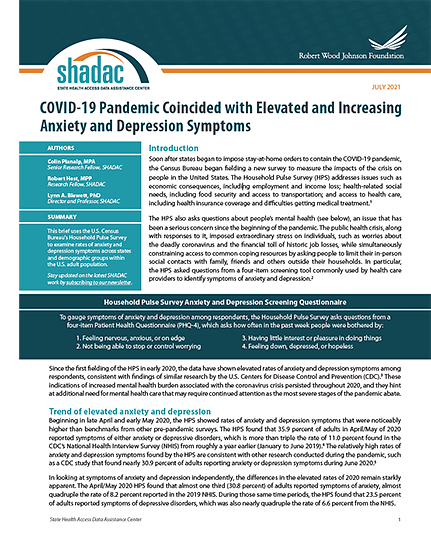Publication
COVID-19 Pandemic Coincided with Elevated and Increasing Anxiety and Depression Symptoms
 SHADAC Director Dr. Lynn Blewett and SHADAC Researchers Colin Planalp and Robert Hest used data from the U.S. Census Bureau’s Household Pulse Survey (HPS) to study rates of anxiety and depression in the U.S. adult population for the months of April to December 2020.
SHADAC Director Dr. Lynn Blewett and SHADAC Researchers Colin Planalp and Robert Hest used data from the U.S. Census Bureau’s Household Pulse Survey (HPS) to study rates of anxiety and depression in the U.S. adult population for the months of April to December 2020.
The brief looks at both combined and individual rates of reported anxiety and depression symptoms for the total adult population as well as by specific breakdowns, including age, gender, race/ethnicity, income and education levels, and employment status.
Designed to provide near-real-time estimates of the economic, financial, and health impacts of the pandemic, the HPS asks questions covering topics such as health insurance coverage, medical treatment, employment status, and job loss, food security, and transportation access, among others. The HPS questions used in the analysis of this brief were adapted by the Census Bureau from a four-item screening tool commonly used by health care providers to identify symptoms of anxiety and depression.
Though the United States is beginning to emerge from the darkest days of the pandemic, it is important to remember that this crisis affected not only physical health, but mental health as well, and these burdens must be continued to be monitored and addressed at the local, state, and national levels. This brief provides an overview of mental health impacts on different portions of the populations, and highlights which groups may benefit from particular outreach to connect them with needed mental health care.
Explore Additional COVID-related SHADAC Work Using the HPS
SHADAC previously wrote a blog post that provided an overview of the Household Pulse Survey (HPS) methodology as well as survey and questionnaire updates.
SHADAC has also used HPS data to track vaccination rates for a range of demographic groups, producing our own state-level estimates of vaccination rates for a biweekly blog series.
Additionally, SHADAC produced a blog studying vaccine hesitancy rates among adults during the first part of 2021.









